Cutting unit set-up - your turf deserves it!
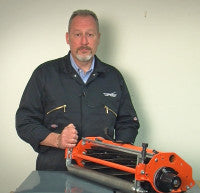
It may seem an obvious statement to make, but you buy a mower to cut grass, so making sure it is correctly set and adjusted to get the best possible finish seems an obvious task. Yet, so many turfcare professionals struggle to do this, despite it being a very simple mechanical adjustment to make. As I travel around the UK, across Europe and further afield, I am constantly surprised at how many cutting units are simply not adjusted correctly.
Until the self-adjusting cylinder unit is designed, you are going to have the task of checking and resetting the gap between the cylinder knives and the bottom blade. So let's take a look at what is involved in doing it right.
It matters not which brand or model you have, the basic principles behind setting any cylinder mowers are the same, and have not changed since the first cylinder mower was invented by Edwin Budding in 1830.
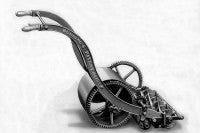
The principle of cutting
Two blades are used in the process; a fixed bottom blade and the rotating cutting cylinder which has multiple spiral blades.
This is the clever part of Budding's design as the spiral cylinder blades ensure a sideways, scything cut, created as the knife travels across the face of the bottom blade. By using multiple blades, this provides several contact points across the face of the bottom blade, ensuring an even and consistent cut.
Adjustment
The two blades, or knives, have to be set very close to each other in order to achieve the above mentioned scything cut. There is some variance between manufacturers over the actual dimensions but, again, the principles are the same;
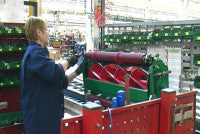
it is essential that the cylinder can freely turn after it is set 'on cut'. If there is anything more than the very lightest of contact, then the friction between the two surfaces will generate heat and expansion, leading to heavier contact and greater heat build-up.
The effect of this heat build-up is not fully appreciated by the layman. The cylinder blades and the bottom blades are carefully heat treated in the factory during manufacture. Heavy contact causes friction, which heats the components again, and then letting them cool naturally removes the hardness gained during manufacture, and they go 'soft'.
Soft blades lose their edge quickly, and so will not stay on cut, regardless of grinding or backlapping. If this process is continued, it is not just the bottom blades which are effected. The cylinder blades can also be affected; and replacing them is an expensive business, so let's avoid it by starting to set our cutting units more carefully.
Mind the gap
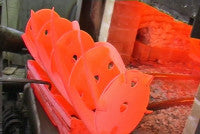
There must be a gap between the blades, to avoid the above issues of friction and heat. So what should the gap be? Well, that depends on the turf your cutting and the conditions you are working in. The operator's instruction manual supplied with your mower will give the manufacturer's advice, and the following works for all cutting units.
A piece of paper (setting strips or photocopier quality paper) is the ideal way to set the gap; you can use feeler gauges or shim steel, but you'll very soon cut the ends off if the cylinders are sharp, so a sacrificial piece of paper is best!
Use the paper as a feeler gauge and slowly reduce the gap at either end of the unit, until the paper will just slide between the two blades. With the gap set, double the paper and spin the cylinder to check the cut, freshly ground units will cut both pieces cleanly; used units which are still sharp enough will cut one, and crease one. A unit that will not cut a piece of paper cleanly, simply will not cut grass cleanly.
Top tip: do not use newspaper as it is too thin for setting cylinders; business cards are too thick for setting fine turf units. Photocopier or printer paper is ideal for the task.

The message here is that the cylinder and bottom blade both have to be sharp and correctly set in order to cut cleanly and efficiently. The health, quality and appearance of the sports surface you are preparing will be adversely effected should you fail to set your units correctly.
If you have set the gap correctly, but the paper is not cleanly cut, but torn or gets jammed between the blades, then the units needs to be sharpened by either backlapping or grinding. Backlapping is acceptable for a quick fix but, to get the unit back to its best, both the bottom blade and the cylinder should be ground.
Click Adjust Units
All modern manufacturers now offer greens units with audible clicker adjusters to aid setting the units on cut. The adjustments are now made from the top of the units, making this even easier to do. However, making it easier has not made it any less important!
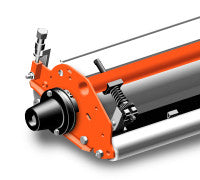
Facilities
Yes, of course you should have a heated, well lit and fully equipped workshop where you can carry out this essential adjustment, and all the other essential maintenance tasks associated with running a modern machinery fleet.
But we appreciate that many of you simply do not have these type of facilities available to you. So what are the basics?
Well, cold and wet hands are no good for setting and adjustments! After using the machine, it must be washed off and allowed to dry before attempting any maintenance. You also need to be comfortable enough to concentrate on the task, and to do it safely and do it well.
Safety

You'll need a clean, level floor to work on and sufficient light to see what you are doing, as well as having the right tools to hand. The operator's handbook should be available, so you can check actual settings as you go.
Gloves should be worn, and use a spanner (or a suitable length of wood) to turn the cylinder, not your fingers! Too many of us have had fingers nipped in cutting units over the years and, unfortunately, many of you will know someone who has lost a finger, so be careful, always use the right tools, and please be aware that you can't set the unit on the machine; get it on the bench!
You should always complete a risk assessment for such essential maintenance tasks, and use this to ensure that your club or business gets you the facilities you need to complete this work correctly and safely.

